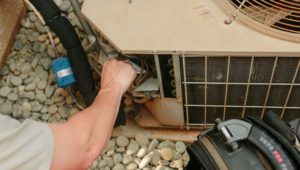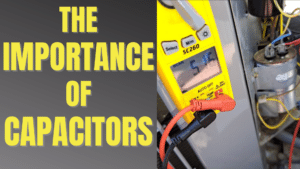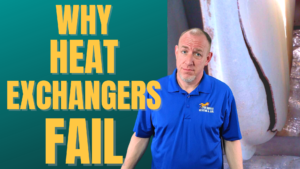In this article, I wanted to address a few things about switching from a gas heater with electric air conditioning to all-electric heating and cooling with a Mitsubishi Ducted Heat Pump.
Why the switch? – Many players in California are “all in” when it comes to the green energy movement and have set a goal for themselves to be carbon neutral by a specific 2030 or 2040.
So, things are already in the works to make this happen smoothly. One of the routes is for home HVAC systems to switch from gas fuel to electric fueled systems.
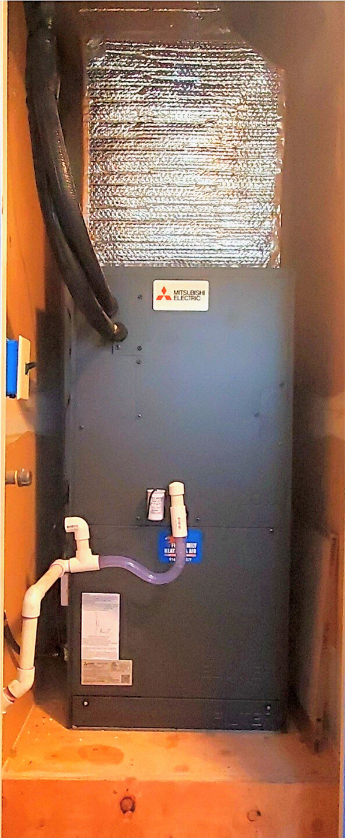
If you live in a home that currently uses natural gas or liquid propane, you aren’t required to make the switch. When your HVAC system is ready to be changed out, you can go right back with a gas/electric system. So, I wanted to make that clear.
I Heard Heat Pumps Don’t Heat Like Gas Furnaces
Now, when we give folks the option of switching to the ducted mini-splits, we usually hear something like, “I heard heat pumps won’t heat as well as my gas furnace.” My answer to that revolves around the fact that if you ask for your house to be 72 degrees, it’s going to be 72 degrees in your house. If you drop it down to 68, it’ll go down to 68, just like a gas furnace.
The air temperature coming out of a Mitsubishi ducted air handler is about 100 degrees. The heat coming out of a gas furnace is around 130. Sometimes higher. So, yes, the heat coming out of a variable speed Mitsubishi ducted heat pump is typically less than the heat coming out of a gas furnace. But unless you’re trying to schedule big temperature swings in your house, like letting it get down to 65 degrees at night and then wanting it to be 74 first thing in the morning, it’s a non-issue.
Is it a race to see how fast the home will go from 68 degrees to 74? If it is, then yes, the gas furnace will take less time to get there every time. Here’s a typical schedule we see on modern thermostats that allow the homeowner to request it to be a specific temperature when you wake up, go to work, come home from work, and go to bed:
Wake up: 68 degrees
Leave for work: Let it drop down to 65 degrees in the house
(which it usually won’t in the daytime anyway)
Return from work: 68 degrees
Sleep: Let it drop down to 65
(because you’re under the covers anyways)
Those are typical settings. And again, the temperature is going to stay on whatever setting you set it for. So, there’s never cool air coming into the house. It’s going to be warm and cozy just the way you like it.
Another point to make with single-stage gas furnaces is the temperatures swing a couple degrees more or less. In contrast, the variable speed Mitsubishi ducted air handler is going to provide a more consistent temperature in your home. It can do that because variable speed systems ramp up and down like a speedometer on your car, providing a steady temperature all day long.
Defrost Cycle – Why the Outdoor Unit Develops Water
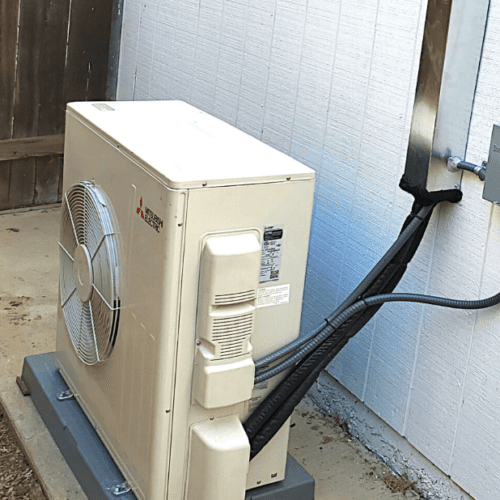
In cooling mode, you have the outdoor unit, which is the hot coil. Inside, you have a cold coil at the air handler, where the blower then sends air across to get your cold air. That cold develops condensation on it, which drains into a PVC pipe that terminates over on the side of the house.
In the heating mode, everything just reverses. Literally, the refrigerant inside the tubing leading from outside to inside switches direction. So, you end up with the cold coil outside and the hot coil on the inside, where the blower sends air across to get your warm air. That cold coil outside will condense water, which on the coldest days, will create frost. Once the outdoor unit has frosted to a certain point, it will defrost. That melted frost becomes clean water which will drain down to the ground surrounding the outdoor unit. It’s not a lot, but enough to make a new heat pump owner think something is wrong.
That’s totally normal for any heat pump to go through this process.
I’ve Heard the Heat Strips Will Increase My Electric Bill
Standard unitary ducted heat pumps, like Goodman, Ruud, Lennox, Carrier, etc., use heat strips to supplement the heat given on the coolest days of the year. Typically, under 38 degrees outdoors. Those heat strips can double the cost of running your heat pump. I’m not going to lie.
What is different about Mitsubishi’s systems is that they are super-efficient even under 30 degrees. Mitsubishi’s units can extract more heat from the outdoor air and bring it inside to you without using its heat strips.
Here’s another thing. We don’t usually install the heat strips for our Sacramento area customers, where 30 degrees is about as cold as it gets for a couple of weeks during the nights. Our previous customers have continued staying warm without them because the system is that efficient.
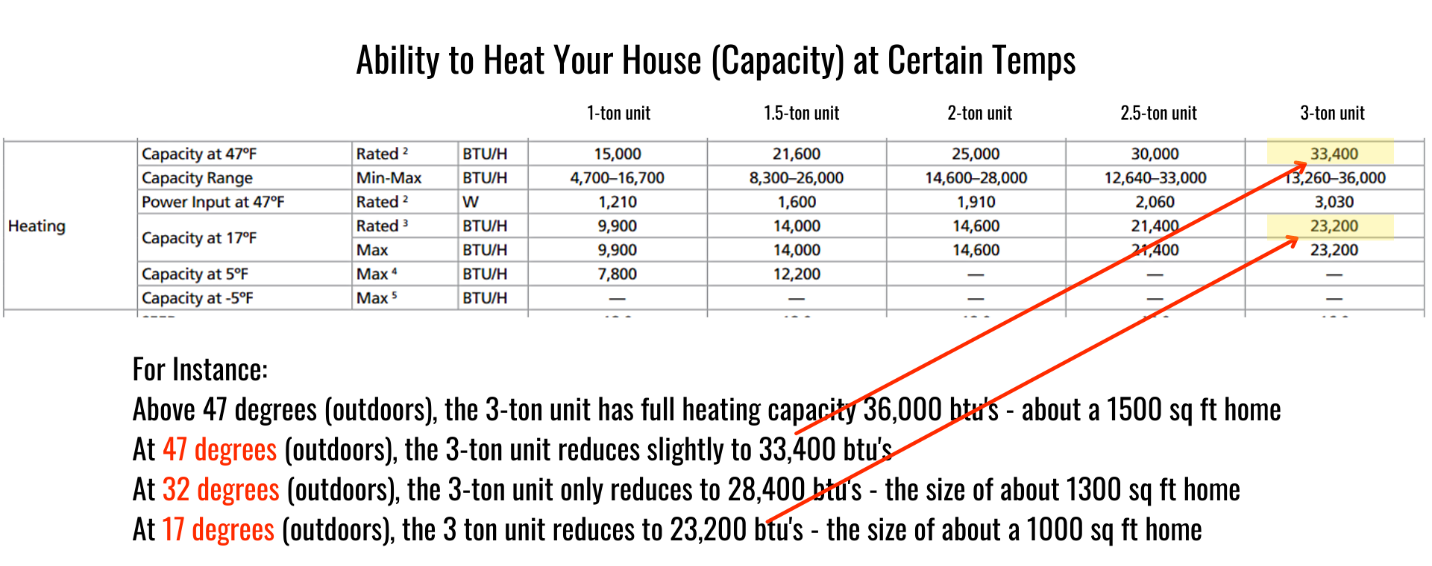
If we lived in a colder climate like Auburn or Placerville, it would be smart to add those heat strips since the temps dip a little lower than 30 at those elevations. In that case, running the system in the wintertime below about 35 to 40 degrees outdoor temperatures will signal the heat strips to come on. That is when the cost to run the heater will rise, because they draw a large amount of electricity to supplement the variable speed heating system. So consider this information when deciding if you want to go with these ducted air handlers.
I do want to make a clarification for you on other air handlers besides the ducted system. I’m talking about the wall mounts, ceiling mounts, and floor mounts. These never have any heating issues in low temps. At least here in the Sacramento Valley. Other parts of the country where it gets below 15 degrees, will want to upgrade to Mitsubishi’s Hyper-Heat outdoor units. They guarantee heat down to -5 degrees!
Why are the SEER ratings a little lower on the larger units?
For one reason or another, the organization that rates the SEER on air conditioners and heat pumps rates the 3- and 4-ton ducted heat pumps a little lower than the smaller tonnage units.
Ducted heat pumps efficiency numbers tend to go down higher than 2.5 tons. I always tell people not to get so caught up in the SEER ratings on systems and focus on the system’s technology. Any variable speed system will utilize less power because it can operate at specific levels, usually lower levels. Standard systems have either one or two stages (or levels) that it runs at. Not hundreds of variable speeds like the more efficient Mitsubishi units have.
Also, if you have to get caught up in numbers, you’d want to look at the HSPF ratings more than the SEER rating when it comes to the heating season. Standard unitary systems have HSPFs around 9 or 10. Whereas the Mitsubishi variable speed ducted heat pump has HSPF numbers around 11 at the lowest and 13.5 on the high end. A big difference from 9 HSPF.
But again, focus on technology. Here is a quick video on single-stage, two-stage, and variable speed technology.
These were questions that we get from new Mitsubishi ducted mini split owners. They aren’t used to variable speed heat pumps, so when they see a little water develop on the ground around the outdoor unit, they tend to call us and ask what is causing it.



